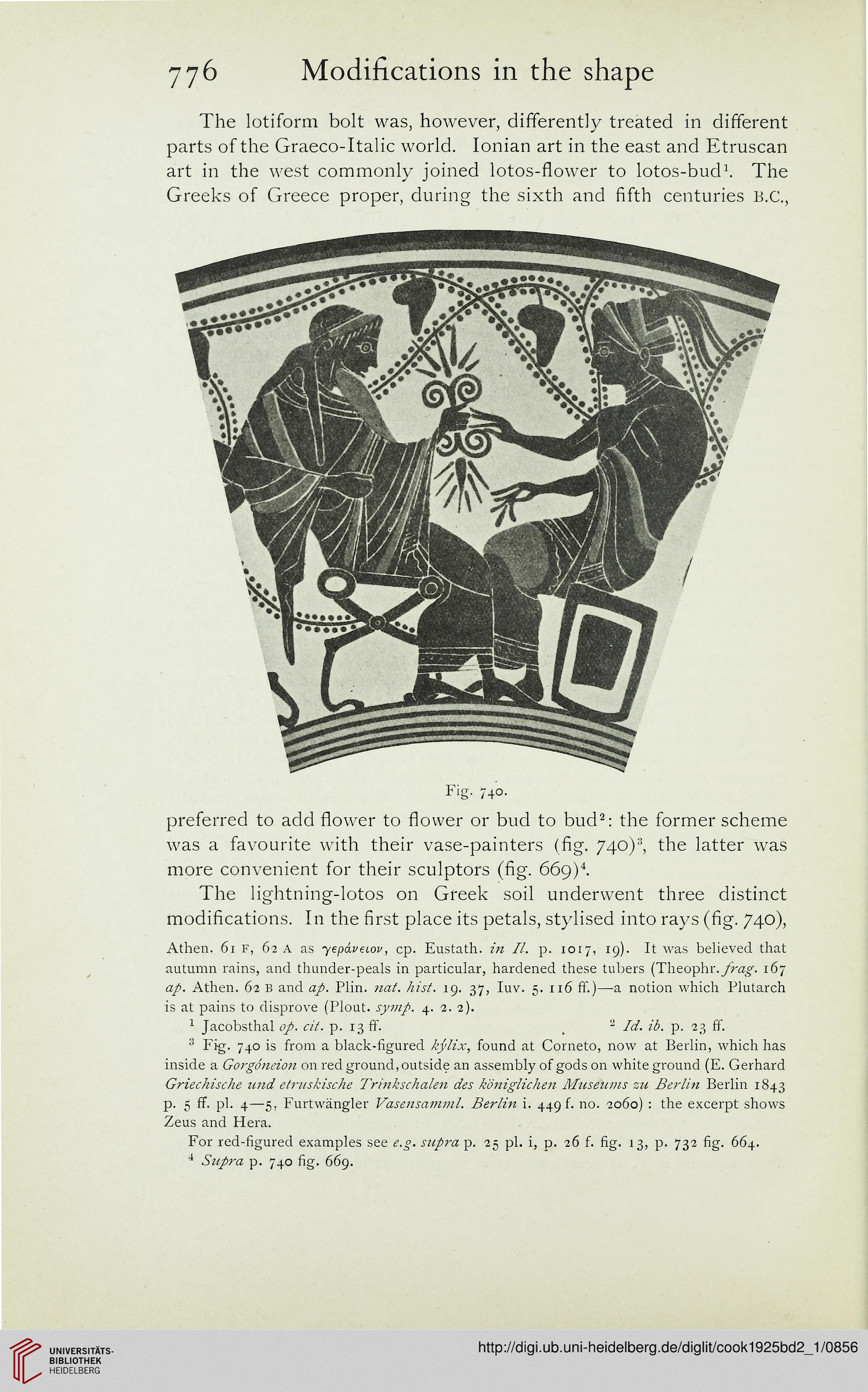776 Modifications in the shape
The lotiform bolt was, however, differently treated in different
parts of the Graeco-Italic world. Ionian art in the east and Etruscan
art in the west commonly joined lotos-flower to lotos-bud1. The
Greeks of Greece proper, during the sixth and fifth centuries B.C.,
Fig. 740.
preferred to add flower to flower or bud to bud2: the former scheme
was a favourite with their vase-painters (fig. 740)3, the latter was
more convenient for their sculptors (fig. 66g)i.
The lightning-lotos on Greek soil underwent three distinct
modifications. In the first place its petals, stylised into rays (fig. 740),
Athen. 61 F, 62 a as yepaveiov, cp. Eustath. in II. p. 1017, 19). It was believed that
autumn rains, and thunder-peals in particular, hardened these tubers (Theophr./rizo'. 167
ap. Athen. 62 B and ap. Plin. nat. hist. 19. 37, Iuv. 5. 116 ff.)—a notion which Plutarch
is at pains to disprove (Plout. synip. 4. 2. 2).
1 Jacobsthal op. cit. p. 13 ff. 2 Id. id. p. 23 ff.
3 Fig. 740 is from a black-figured kylix, found at Corneto, now at Berlin, which has
inside a Gorgoneion on red ground, outside an assembly of gods on white ground (E. Gerhard
Griechische und etruskische Trinkschalen des koniglichen Museums zu Berlin Berlin 1843
p. 5 ff. pi. 4—5, Furtwangler Vasensamml. Berlin i. 449 f. no. 2060) : the excerpt shows
Zeus and Hera.
For red-figured examples see e.g. supra p. 25 pi. i, p. 26 f. fig. 13, p. 732 fig. 664.
4 Supra p. 740 fig. 669.
The lotiform bolt was, however, differently treated in different
parts of the Graeco-Italic world. Ionian art in the east and Etruscan
art in the west commonly joined lotos-flower to lotos-bud1. The
Greeks of Greece proper, during the sixth and fifth centuries B.C.,
Fig. 740.
preferred to add flower to flower or bud to bud2: the former scheme
was a favourite with their vase-painters (fig. 740)3, the latter was
more convenient for their sculptors (fig. 66g)i.
The lightning-lotos on Greek soil underwent three distinct
modifications. In the first place its petals, stylised into rays (fig. 740),
Athen. 61 F, 62 a as yepaveiov, cp. Eustath. in II. p. 1017, 19). It was believed that
autumn rains, and thunder-peals in particular, hardened these tubers (Theophr./rizo'. 167
ap. Athen. 62 B and ap. Plin. nat. hist. 19. 37, Iuv. 5. 116 ff.)—a notion which Plutarch
is at pains to disprove (Plout. synip. 4. 2. 2).
1 Jacobsthal op. cit. p. 13 ff. 2 Id. id. p. 23 ff.
3 Fig. 740 is from a black-figured kylix, found at Corneto, now at Berlin, which has
inside a Gorgoneion on red ground, outside an assembly of gods on white ground (E. Gerhard
Griechische und etruskische Trinkschalen des koniglichen Museums zu Berlin Berlin 1843
p. 5 ff. pi. 4—5, Furtwangler Vasensamml. Berlin i. 449 f. no. 2060) : the excerpt shows
Zeus and Hera.
For red-figured examples see e.g. supra p. 25 pi. i, p. 26 f. fig. 13, p. 732 fig. 664.
4 Supra p. 740 fig. 669.




